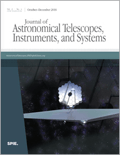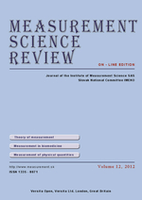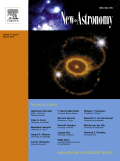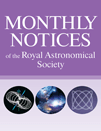
Journal of Astronomical Telescopes Instruments and Systems
Scope & Guideline
Unveiling the Universe: Your Gateway to Groundbreaking Research
Introduction
Aims and Scopes
- Instrumentation Design and Development:
The journal emphasizes novel designs and developments of astronomical instruments, including telescopes, spectrometers, and detectors that improve observational capacities. - Calibration Techniques:
A significant focus is on methodologies for calibrating astronomical instruments to ensure accurate measurements and data quality. - Performance Analysis:
The journal publishes research on the performance evaluation of astronomical systems and components, including error budgets and optimization strategies. - Adaptive Optics and Imaging Techniques:
Research on adaptive optics systems and imaging techniques that enhance resolution and contrast in astronomical observations is a core area of interest. - Space and Ground-Based Observations:
The journal covers both space-borne and ground-based observational systems, highlighting the unique challenges and solutions in each domain. - Detector Technology:
Innovations in detector technologies, including CMOS, CCDs, and emerging materials for enhanced sensitivity and resolution, are regularly explored.
Trending and Emerging
- Machine Learning Applications:
Recent publications indicate a growing trend towards integrating machine learning techniques in data analysis, calibration, and instrument optimization, showcasing the potential of AI in enhancing observational capabilities. - Exoplanet Detection and Imaging:
Research on advanced techniques for exoplanet detection, including the use of starshade technology and coronagraphy, is increasingly prominent, reflecting the current interest in understanding planetary systems. - Miniaturized and CubeSat Instruments:
There is a rising focus on the development of miniaturized instruments and CubeSats for astronomical observations, which offer cost-effective solutions for space research. - High-Performance Detectors:
Innovations in detector technologies, particularly in achieving higher sensitivity and resolution, are trending, with a focus on the development of novel materials and architectures. - Enhanced Imaging Techniques:
Emerging techniques that improve imaging quality and resolution, such as advanced adaptive optics and wavefront sensing, are gaining attention, reflecting the need for better observational accuracy.
Declining or Waning
- Traditional Optical Telescopes:
Research focusing solely on traditional optical telescopes seems to be waning as more advanced technologies and methods, such as adaptive optics and space-based instruments, gain traction. - Basic Calibration Methods:
Papers discussing basic calibration methods without innovative advancements or new technologies are less frequent, indicating a shift towards more sophisticated calibration techniques. - Single-Purpose Instruments:
There is a noticeable decrease in the publication of studies related to single-purpose instruments, as multi-functional and adaptable systems become more desirable.
Similar Journals

Journal of the Korean Astronomical Society
Illuminating the Universe: Pioneering Research in Space ScienceWelcome to the Journal of the Korean Astronomical Society, an esteemed publication dedicated to advancing the fields of Astronomy and Astrophysics as well as Space and Planetary Science. Established in 1993 and under the reputable auspices of the Korean Astronomical Society, this journal serves as a vital platform for researchers and scholars from South Korea and around the globe to disseminate innovative findings and critical insights. With a commendable Q2 ranking in Astronomy and Astrophysics and a Q3 ranking in Space and Planetary Science, this journal is positioned among the influential voices in its fields, fostering collaboration and knowledge exchange. The journal's rigorous peer-review process ensures that published works contribute significantly to ongoing discussions and developments in astronomical research. While currently not an open-access journal, it remains accessible to the academic community, encouraging readers to stay abreast of the latest advancements in the sciences that elucidate the universe's complexities. Join us in exploring the cosmos through cutting-edge research and scholarly discussion that propels the field forward.

Astrophysical Bulletin
Advancing Knowledge in Astronomy and AstrophysicsWelcome to the Astrophysical Bulletin, an esteemed journal published by MAIK NAUKA/INTERPERIODICA/SPRINGER that has been contributing to the fields of Astronomy and Astrophysics since its inception in 2009. With a prominent Q3 rating in both Astronomy and Astrophysics and Instrumentation, this journal is designed to foster an understanding of astronomical phenomena through comprehensive research articles and groundbreaking discoveries. While currently not offering open access, it remains a vital resource for researchers and professionals looking to stay informed on the latest advances in the field, featuring a compelling selection of peer-reviewed studies that underscore its relevance and impact. The Astrophysical Bulletin ranks impressively in Scopus, making it a trusted platform for disseminating vital knowledge and new insights into our universe.

Contributions of the Astronomical Observatory Skalnate Pleso
Advancing Knowledge: Unveiling the Mysteries of the UniverseContributions of the Astronomical Observatory Skalnate Pleso, published by the Slovak Academy of Sciences Astronomical Institute, serves as a vital platform for the dissemination of research in the realm of Astronomy and Astrophysics. With its ISSN number 1335-1842 and E-ISSN 1336-0337, this esteemed journal aims to foster scientific discourse and innovation among researchers, professionals, and students alike. Although it currently holds a Q4 quartile ranking in its field as of 2023, the journal encourages contributions that enhance our understanding of universe dynamics and celestial phenomena through rigorous research methodologies. Spanning from its inaugural year in 2007 to the projected continuation through 2024, it integrates local insights from Slovakia with broader international endeavors in astronomy. The journal promotes an open-access approach, providing scholars unrestricted access to valuable findings and discussions, thereby advancing the boundaries of astronomical knowledge.

PUBLICATIONS OF THE ASTRONOMICAL SOCIETY OF JAPAN
Illuminating the cosmos with cutting-edge discoveries.Publications of the Astronomical Society of Japan is a prestigious, peer-reviewed journal dedicated to advancing the field of astronomy and astrophysics. Published by Oxford University Press, this journal provides a platform for high-quality research, fostering scientific communication among both established researchers and emerging scholars. With an ISSN of 0004-6264 and E-ISSN 2053-051X, it is recognized for its significant impact in its field, boasting a Q2 ranking in both Astronomy and Astrophysics and Space and Planetary Science as of 2023. The journal seeks to bridge traditional and innovative approaches to expand understanding of celestial phenomena, making it an essential resource for professionals, students, and researchers alike. Researchers can access a wealth of cutting-edge studies spanning theoretical and observational aspects of astronomy from its inception in 1996 to the present day. Although the journal operates under a traditional access model, it remains a respected forum for pivotal discoveries and discussions within the global astronomical community.

Measurement Science Review
Connecting Ideas in Biomedical and Engineering MeasurementsMeasurement Science Review is a distinguished open-access journal published by SCIENDO, dedicated to advancing the field of measurement science across various disciplines, including Biomedical Engineering, Control and Systems Engineering, and Instrumentation. Since its inception in 2008, it has actively contributed to the dissemination of innovative research and practices relevant to these fields, currently holding a notable Q3 ranking in its category as per the 2023 metrics. With an emphasis on robust scientific inquiry and practical applications, Measurement Science Review is positioned as an essential resource for researchers, professionals, and students seeking to enhance their understanding and expertise in measurement technologies. The journal provides an accessible platform for interdisciplinary dialogue and collaboration, making it a vital component of the academic landscape in Slovakia and beyond. Its publication track extends to 2024, ensuring timely access to cutting-edge research findings for a global audience.

Atmospheric Measurement Techniques
Fostering Collaboration in Atmospheric Research Excellence.Atmospheric Measurement Techniques, published by COPERNICUS GESELLSCHAFT MBH, is a premier open-access journal that has been contributing to the field of atmospheric science since 2008. With its focus on advancing techniques for atmospheric observations and measurements, the journal has established itself as an authoritative source with a Q1 ranking in the Atmospheric Science category for 2023, placing it among the top journals in the field. Based in Germany, its commitment to accessibility ensures that researchers, professionals, and students can freely engage with high-quality research that influences environmental monitoring, climate studies, and atmospheric modeling. As of 2023, it successfully ranks 32nd out of 148 in Earth and Planetary Sciences—demonstrating its significant impact in the scientific community with a commendable 78th percentile status within this dynamic domain. Researchers focusing on innovative atmospheric measurement techniques will find this journal a vital platform for disseminating their findings and collaborating on cutting-edge research.

NEW ASTRONOMY
Exploring the Frontiers of Cosmic KnowledgeNEW ASTRONOMY, published by Elsevier, stands as a pivotal platform in the field of Astronomy and Astrophysics. With an ISSN of 1384-1076 and an E-ISSN of 1384-1092, this journal has solidified its reputation over its operational years, from 1996 to 2025. Located in the Netherlands, it ranks in the Q2 category for Astronomy and Astrophysics and Instrumentation, and Q3 for Space and Planetary Science, affirming its significant contribution to these disciplines. With a Scopus rank of #37/90 in Astronomy and Astrophysics and a respectable 59th percentile, this journal is essential for researchers and professionals seeking cutting-edge findings and methodologies. Although not open access, NEW ASTRONOMY remains dedicated to providing a rich repository of knowledge, featuring exceptional peer-reviewed articles that explore novel astronomical phenomena and advancements in instrumentation. Engaging with this journal will not only enhance your understanding of current trends in the cosmos but also contribute to the ongoing dialogue within these dynamic fields.

Advances in Astronomy and Space Physics
Fostering Innovation in the Study of the Cosmos.Advances in Astronomy and Space Physics is an esteemed journal dedicated to the exploration and dissemination of research in the expansive fields of astronomy and space science. Published by Taras Shevchenko National University of Kyiv, this journal provides a platform for researchers, professionals, and students to share groundbreaking studies and innovations. With an ISSN of 2227-1481, it covers a wide range of subjects including astrophysics, planetary sciences, and space exploration technologies, thereby fostering interdisciplinary collaboration. Although not an Open Access journal, it maintains a commitment to high-quality, peer-reviewed content that contributes significantly to the advancement of scientific knowledge. The journal's mission is to promote sustainable practices in space research while also exploring the implications of discoveries on Earth and beyond. By maintaining rigorous publication standards, Advances in Astronomy and Space Physics aims to serve as a critical resource for those involved in the ever-evolving study of our universe.

MONTHLY NOTICES OF THE ROYAL ASTRONOMICAL SOCIETY
Charting New Frontiers in Astrophysical Research.The MONTHLY NOTICES OF THE ROYAL ASTRONOMICAL SOCIETY (MNRAS), published by Oxford University Press, serves as a premier platform for the dissemination of significant research in the fields of Astronomy, Astrophysics, and Space and Planetary Science. Established in 1913 and with an impressive impact factor reflected in its 2023 Q1 rankings—13th in Earth and Planetary Sciences and 14th in Physics and Astronomy—this journal is renowned for its rigorous peer-reviewed articles, fostering advancements in our understanding of the universe. Researchers, professionals, and students alike benefit from its rich content, which spans a vast array of topics within its scope, from stellar dynamics to planetary formation. While the journal does not currently offer Open Access options, the scholarly contributions published herein are invaluable for pushing the boundaries of contemporary scientific inquiry and ensuring that the latest findings reach an engaged audience globally.

Kinematics and Physics of Celestial Bodies
Decoding the Motion of the Universe's BodiesKinematics and Physics of Celestial Bodies is a prominent journal published by PLEIADES PUBLISHING INC, dedicated to the exploration and understanding of celestial mechanics and the physical properties of astronomical bodies. With an ISSN of 0884-5913 and an E-ISSN of 1934-8401, this journal has established itself as a resource for researchers in the fields of astronomy, astrophysics, and space science since its inception in 2009. The journal is indexed in Scopus, where it currently ranks in the fourth quartile for both Astronomy and Astrophysics and Space and Planetary Science, making it a valuable platform for scholarly discourse despite its ranking. Its scope encompasses a range of topics related to the kinematics and physical characteristics of celestial objects, aiming to facilitate a better understanding of their dynamics and interactions within the universe. Although it does not operate under an open access model, the journal provides essential insights and findings, catering to the academic needs of researchers, professionals, and students engaged in the study of the cosmos. The journal's commitment to advancing knowledge in the various aspects of celestial physics ultimately contributes to the broader scientific community's endeavors.